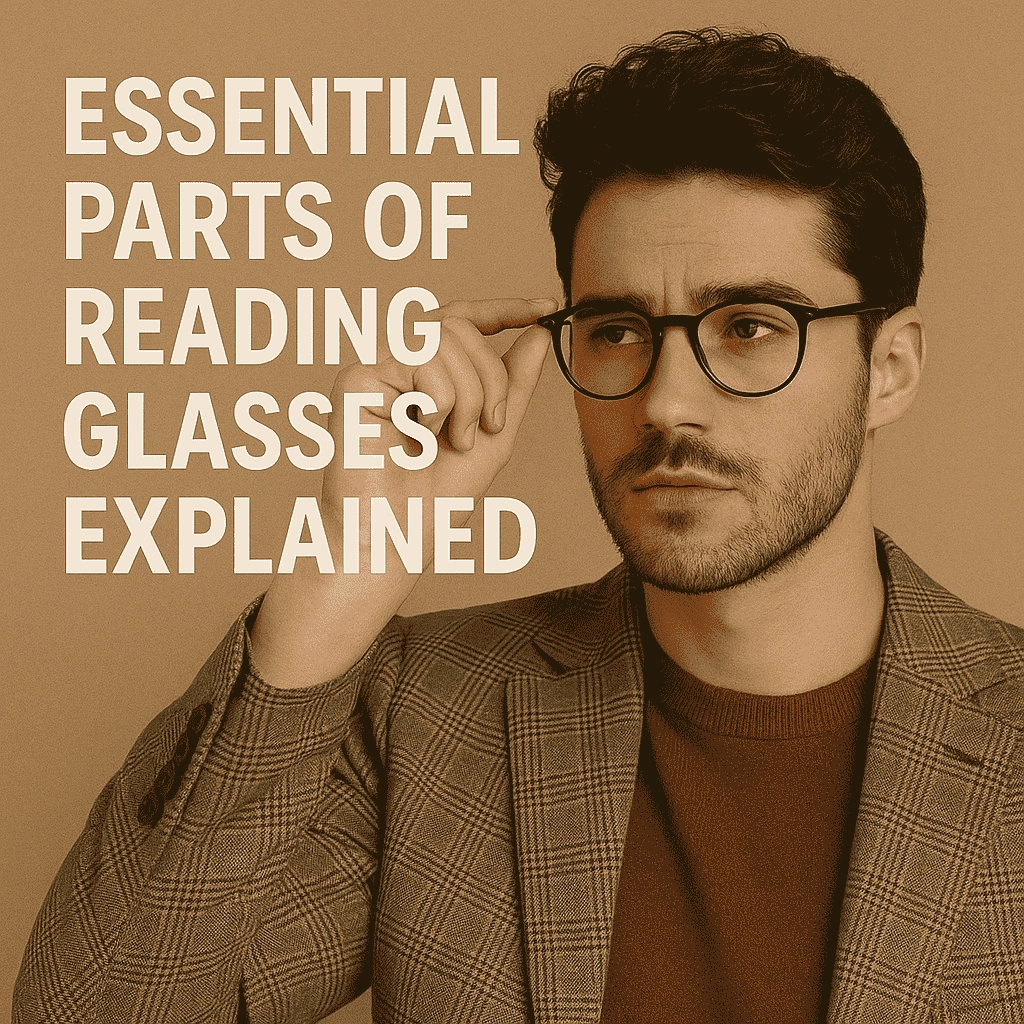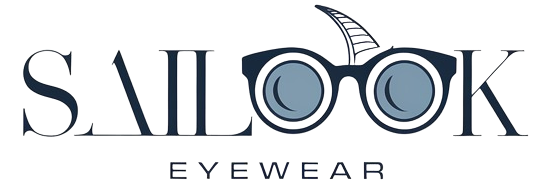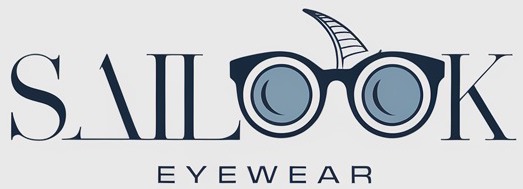When it comes to understanding reading glasses, it’s crucial to know the different parts that make up these essential tools for better vision. Each component plays a vital role in providing comfort, durability, and effectiveness. In this article, we’ll break down the various parts of reading glasses, their functions, and how to select the right components to meet your needs. Whether you’re designing custom eyewear for your business or selecting the perfect pair for personal use, understanding the parts of reading glasses is essential for making informed decisions.

1. What Are the Main Parts of Reading Glasses?
Reading glasses may appear simple at first glance, but they are composed of several important parts that work together to offer clarity and comfort. The main components include the frame, lenses, hinges, and nose pads. But here’s the kicker—each of these parts can dramatically influence the style, fit, and durability of the glasses. Let’s break down each part to understand its role:
| Part | Description |
|---|---|
| Frame | Holds the lenses in place and influences overall style and comfort. Available in many materials. |
| Lenses | Correct vision by magnifying text or objects at close range. Can be customized with coatings and types. |
| Hinges | Connect the temples to the frame, allowing the glasses to fold for storage and offering flexibility. |
| Nose Pads | Ensure the glasses stay securely on your nose without causing pressure or discomfort. |
2. What Are the Functions of the Frame in Reading Glasses?
The frame of reading glasses is not just about holding the lenses in place—it also affects comfort, style, and durability. But here’s the deal, the right frame can make a significant difference in how well your glasses fit and feel. Frames come in various shapes, sizes, and materials, each offering unique benefits.
| Material | Benefits | Common Usage |
|---|---|---|
| Plastic | Lightweight, flexible, affordable. | Ideal for fashion-forward designs and everyday wear. |
| Metal | Durable, sleek, minimalistic design. | Suitable for professional or modern looks. |
| Titanium | Extremely durable, lightweight, corrosion-resistant. | Perfect for active users and those seeking durability. |
| Acetate | High-quality, luxurious look with color and pattern options. | Often used for stylish, high-end eyewear. |
3. How Do Lenses Work in Reading Glasses?
Lenses are the heart of reading glasses, designed to correct vision for close-up tasks like reading or sewing. But what’s the real story behind lenses? They are crafted to provide magnification for near vision, making small text easier to see and reducing eye strain.
| Lens Type | Description | Ideal for |
|---|---|---|
| Single Vision Lenses | Provide one magnification power throughout the entire lens. | Those who need help with close-up vision. |
| Bifocal Lenses | Two prescriptions in one lens—one for distance and one for near vision. | People who need correction for both near and far vision. |
| Progressive Lenses | Smooth transition between distance and near vision, no visible lines. | Those requiring multi-distance correction. |
4. What Are the Different Types of Lenses for Reading Glasses?
The type of lenses you choose for reading glasses depends on your specific needs. So, you might be wondering, what are the different types of lenses available for reading glasses? Understanding these options will help you select the perfect lenses for your vision correction.
| Lens Type | Features | Ideal User |
|---|---|---|
| Single Vision Lenses | One magnification power for close vision. | Those who need help seeing objects at a close distance. |
| Bifocal Lenses | Two distinct prescriptions for distance and near vision. | People who need correction for both long-distance and close-up tasks. |
| Progressive Lenses | Gradual transition between different prescriptions. | People needing seamless vision correction for various distances. |
5. Why Are Hinges Important in Reading Glasses?
Hinges play an often-overlooked but critical role in reading glasses. What’s the deal with hinges? They’re the small but mighty components that allow the arms of the glasses to fold inward, making them easy to store and transport.
| Hinge Type | Function | Benefits |
|---|---|---|
| Traditional Hinges | Simple and effective, allows the arms to fold. | Reliable, low maintenance, simple design. |
| Spring Hinges | Allow extra flexibility, with a spring mechanism for a better fit. | Provides more comfort and better adaptability to different head sizes. |
6. How Do Nose Pads Contribute to Comfort in Reading Glasses?
Nose pads are small, often overlooked components of reading glasses that play a huge role in overall comfort. Ready for the good part? Nose pads ensure that your glasses sit securely on your nose without causing pressure or discomfort, especially during long periods of wear.
| Nose Pad Type | Material | Benefit |
|---|---|---|
| Adjustable Nose Pads | Silicone, Rubber, Plastic | Can be customized for a comfortable fit. |
| Fixed Nose Pads | Plastic, Acetate, Metal | Non-adjustable, typically more durable, but less flexible. |
7. What Should You Look for in a Frame Material for Reading Glasses?
Choosing the right frame material is critical to the comfort and durability of your reading glasses. What’s the real story? The material not only affects the weight and comfort of the glasses but also influences their style, flexibility, and resistance to wear.
● Plastic Frames – Plastic frames are lightweight, flexible, and affordable. They come in a wide range of colors and designs, making them a popular choice for fashion-forward readers.
● Metal Frames – Metal frames are known for their strength and sleek look. They’re usually thinner and more durable, making them ideal for those who prefer a more sophisticated, minimalistic design.
● Titanium Frames – Titanium is a highly durable, lightweight, and corrosion-resistant material. Titanium frames are often chosen for their strength and comfort, making them ideal for those with active lifestyles.
● Acetate Frames – Acetate is a high-quality plastic that offers flexibility, comfort, and style. It’s available in various colors and patterns, providing a luxurious look and feel to your glasses.
8. How Do You Choose the Right Lenses for Your Reading Glasses?
Choosing the right lenses for your reading glasses is essential for ensuring optimal vision and comfort. This is where it gets interesting… Selecting lenses involves considering your specific vision needs, preferences, and lifestyle.
● Consider Prescription Needs – If you have a specific prescription, it’s essential to choose lenses that match. Whether you need single vision, bifocal, or progressive lenses, selecting the right prescription is the first step in choosing the right lenses.
● Lens Coatings – Adding coatings to your lenses can enhance their performance. Anti-glare coatings reduce reflections from screens or bright lights, while blue light filters help protect against eye strain from digital devices.
● Lifestyle Needs – If you’re an active person, consider lenses that offer extra durability and impact resistance, such as polycarbonate lenses. If you’re using your glasses for long hours in front of a screen, a blue light filter coating may be beneficial.
9. What Is the Importance of Lens Thickness in Reading Glasses?
Lens thickness is an important consideration when choosing reading glasses. Here’s the kicker— the thickness of the lens directly impacts both its appearance and functionality. Thicker lenses tend to be heavier and more noticeable, while thinner lenses are lighter and more stylish.
● Prescription Strength – The thickness of the lens depends on the strength of your prescription. Stronger prescriptions often require thicker lenses, which can be more noticeable and heavier.
● Lens Material – Some lens materials are naturally thinner than others. High-index lenses, for example, are thinner and lighter, making them ideal for strong prescriptions.
● Aesthetics – Thinner lenses are generally more aesthetically pleasing, as they create a sleeker and more streamlined look. Many people prefer thin lenses for both style and comfort.
10. How Do You Adjust the Fit of Your Reading Glasses?
Adjusting the fit of your reading glasses is crucial to ensuring comfort and preventing strain on your face. What’s the deal with adjustments? Proper fitting glasses can improve your vision, comfort, and overall experience.
● Adjusting the Frame – You can adjust the nose pads, temples, and arms of the frame to ensure a snug fit. A well-adjusted frame prevents the glasses from slipping down or causing pressure points on your nose.
● Professional Adjustment – If you’re unsure how to adjust your glasses, many eyewear retailers and opticians can make adjustments for you. This is a great option for ensuring the perfect fit.
● DIY Adjustments – Some minor adjustments can be done at home, such as adjusting the temples to better fit the width of your head. However, be careful not to damage the frame or lenses when making these adjustments.
11. How Do You Maintain the Parts of Your Reading Glasses?
Maintaining your reading glasses ensures that they last longer and continue to perform well. Here’s the secret— proper care helps prevent damage and keeps your glasses in great condition for years.
● Cleaning Lenses – To clean lenses, use a microfiber cloth and gentle lens cleaner. Avoid using paper towels or other rough materials that can scratch the lens surface.
● Caring for the Frame – Wipe the frame regularly to remove dirt and oils. Store your glasses in a protective case when not in use to avoid accidental damage.
● Checking for Loose Screws – Periodically check the screws on the frame, particularly around the hinges and nose pads. Tighten any loose screws to ensure your glasses stay secure.
12. What Are the Most Common Problems with the Parts of Reading Glasses?
Like any product, reading glasses can experience issues over time. What are the most common problems? Let’s explore some of the typical challenges that users face and how to address them.
● Broken Hinges – Hinges are one of the most common areas where glasses break. Regularly check the hinges for wear and tear, and consider replacing them if they start to lose their flexibility.
● Scratched Lenses – Scratches on the lenses can hinder vision. Always store your glasses in a case when not in use to prevent lens damage.
● Loose Nose Pads – Loose nose pads can cause the glasses to slip or feel uncomfortable. Make sure the nose pads are properly adjusted and secure.
13. How Can You Customize the Parts of Your Reading Glasses?
Customization options are one of the most appealing aspects of reading glasses. Want to make your glasses stand out? Here’s how you can personalize different parts of your eyewear.
● Frame Style and Color – Many eyewear manufacturers allow you to customize the frame’s color, style, and design. This is ideal for creating a unique, personalized pair of glasses.
● Lens Customization – You can select lens coatings, tints, or even add your prescription if needed. Custom lenses ensure that you get the exact vision correction you require.
● Nose Pads and Hinges – Some brands offer customizable nose pads and hinges to enhance comfort or add a personal touch.
14. How Do Different Styles of Frames Affect the Parts of Reading Glasses?
Different frame styles not only affect the look of the glasses but also influence the fit and performance of the other parts. Let’s explore how frame styles impact the overall design of reading glasses.
● Shape and Size – Square frames, round frames, and rectangular frames all affect how the lenses sit and how the weight is distributed.
● Material Influence – Different materials provide different levels of comfort, flexibility, and resistance to wear and tear. For example, metal frames tend to be lighter but less flexible than plastic frames.
● Design Impact – A heavy frame may require thicker lenses or better nose pad support to ensure comfort.
15. What Are the Latest Trends in the Parts of Reading Glasses?
The eyewear industry is constantly evolving, with new technologies and trends emerging. This is where it gets exciting— let’s dive into the latest trends in reading glasses parts.
● Smart Glasses – Incorporating technology into reading glasses, smart glasses feature built-in displays or augmented reality.
● Eco-Friendly Materials – Many brands are now focusing on sustainable materials, such as recycled plastics and biodegradable frames.
● Innovative Lens Coatings – Anti-blue light lenses are gaining popularity, especially with the rise of digital screen usage.
Conclusion
In this article, we’ve thoroughly explored the essential components of reading glasses, from the frame to the lenses, hinges, and nose pads. Each part plays a crucial role in ensuring comfort, durability, and optimal vision correction. By understanding the functionality of these parts, you can make informed decisions when choosing or customizing your reading glasses. Whether you are designing eyewear for a brand or selecting the perfect pair for personal use, knowing the details will help you achieve the best fit and performance. Remember, the right combination of frame, lenses, and customization options will enhance both comfort and style.
FAQ Section
Q1: What are the main parts of reading glasses?
Reading glasses consist of the frame, lenses, hinges, and nose pads, each serving a specific purpose to ensure comfort and vision correction.
Q2: How do reading glasses lenses work?
Lenses are designed to magnify objects for close-up viewing, correcting conditions like presbyopia, which affects the ability to focus on near objects.
Q3: What materials are used in the frames of reading glasses?
Frames can be made from plastic, metal, titanium, or acetate, each offering different benefits in terms of durability, comfort, and style.
Q4: How do nose pads affect the comfort of reading glasses?
Nose pads ensure that the glasses stay in place while providing a comfortable fit. Adjustable nose pads allow for customization, making them suitable for different nose shapes.
Q5: Can I customize the parts of my reading glasses?
Yes, you can customize the frame style, lens coatings, nose pads, and even the material of the parts to match your style and comfort preferences.

